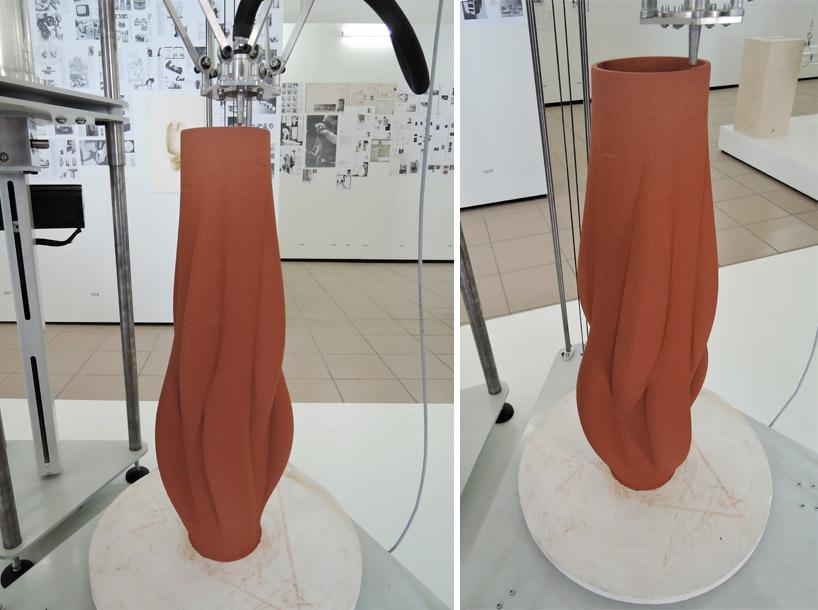Design student and ceramist Olivier van Herpt’s 3D printed ceramics, unveiled during Design Week in Milan, are visually stunning. Larger in scale than one would expect with 3D printed objects, the pieces confront issues of food production, containment, and consumption as part of an exhibition with a surprising and humorous title: Eat Shit.
Van Herpt attends the Design Academy Eindhoven in the southern Netherlands. The prominent design school is tackling one of the central issues of our era: How to feed the Earth’s ever-increasing population in the face of dwindling resources in many regions. The DAE has added a new department called “Food Non Food” and, as such, they are at the forefront of a growing trend for universities to offer such programs that confront “contemporary food culture.”
“…Food is not just fuel for the body, it is also fundamental for shaping our identity…Broadly speaking food is energy,” explained Marije Vogelzang, head of the program. “The subject of food is increasingly urgent across the globe. There is so much happening in the world of food, extensive industrialization, exploitation, animal welfare, the decimation of bee populations…For the designer of the future and within design education there is much potential in this yet to be explored field of study.”
In the interest of promoting their new program, the DAE audaciously launched a “part exhibition, part public laboratory” titled Eat Shit during Milan Design Week 2015 at the Ventura Lambrate exhibition in Italy. The entire Food Non Food department, including students and faculty, presented research and projects. Van Herpt’s 3D printed ceramics were a highlight of the show.
 Van Herpt developed a technique for 3D printing medium- and large-scale ceramics using a 3D printer adjusted to accommodate a larger build volume. The pieces he submitted were part of two of the young design student’s collections, 3D Woven and Sediment. The vessels are all comprised of thin layers of ceramic material.
Van Herpt developed a technique for 3D printing medium- and large-scale ceramics using a 3D printer adjusted to accommodate a larger build volume. The pieces he submitted were part of two of the young design student’s collections, 3D Woven and Sediment. The vessels are all comprised of thin layers of ceramic material.
Van Herpt contends that “there is a saturation of rapid prototyping solutions on the market” but that “many aren’t capable of producing objects at human scale.” Therefore, he spent two years creating a 3D printer that he could program both to move in a particular, designated pattern and to extrude at predetermined intervals, stopping and starting rather than printing–or, “excreting” as he put it, in keeping with the exhibition’s title.
“I like how this machine deals with clay,” van Herpt explained, “which is really just decomposed biological material and river sediment. As a material, clay ends up becoming very personal. A designer works and moulds it and eventually comes to identify with the result. In a similar way, a human being identifies with his or her poo – we could even go so far as saying that while a designer makes and then identifies with clay, a person makes and then identifies with poo – internal evidence of an external mood. It is, after all, always about identifying with a creative process.”
Pushing the exhibition’s theme a bit further than is perhaps required but doing so rather cleverly, van Herpt inspires some pretty compelling if not slightly repugnant allusions to the connection between his work and food. Even the squeamish, however, should be impressed with the work van Herpt has done in terms of adapting 3D printing technology to make feasible larger-scale, non-industrial production.
What do you think of his efforts? Let us know your thoughts in the 3D Printing Ceramics Exhibit forum thread over at 3DPB.com.
Subscribe to Our Email Newsletter
Stay up-to-date on all the latest news from the 3D printing industry and receive information and offers from third party vendors.
You May Also Like
Precision at the Microscale: UK Researchers Advance Medical Devices with BMF’s 3D Printing Tech
University of Nottingham researchers are using Boston Micro Fabrication‘s (BMF) 3D printing technology to develop medical devices that improve compatibility with human tissue. Funded by a UK grant, this project...
3D Printing Webinar and Event Roundup: April 21, 2024
It’s another busy week of webinars and events, starting with Hannover Messe in Germany and continuing with Metalcasting Congress, Chinaplas, TechBlick’s Innovation Festival, and more. Stratasys continues its advanced training...
3D Printing Webinar and Event Roundup: March 17, 2024
It’s another busy week of webinars and events, including SALMED 2024 and AM Forum in Berlin. Stratasys continues its in-person training and is offering two webinars, ASTM is holding a...
3D Printed Micro Antenna is 15% Smaller and 6X Lighter
Horizon Microtechnologies has achieved success in creating a high-frequency D-Band horn antenna through micro 3D printing. However, this achievement did not rely solely on 3D printing; it involved a combination...































